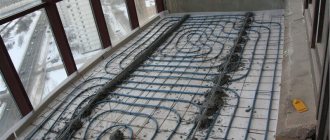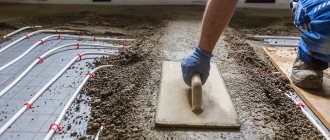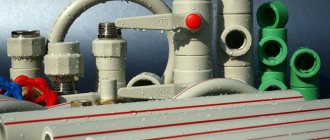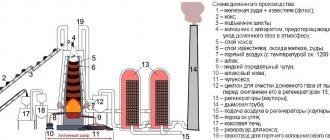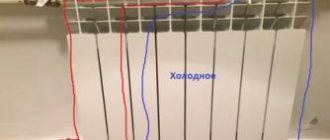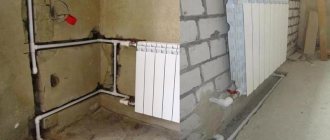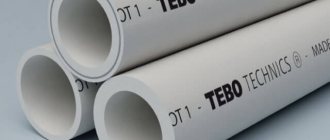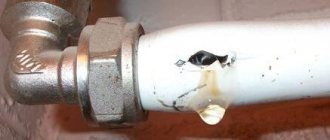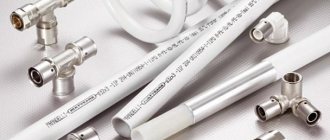The truth without embellishment
If we consider a modern radiator, we can note that this is a technically complex device that works on the principle of convection and radiation. Manufacturers in the process of manufacturing such devices take into account several factors, using new technologies, trying to increase the efficiency of the heating system, reduce the temperature and volume of the coolant. A factory-made device will work much more efficiently than a homemade one, and will also surpass it in design and compactness.
Therefore, it is advisable to make a homemade heating radiator if you have inexpensive or free pipes, appropriate tools for cutting metal, a welding machine and appropriate skills in working with equipment. For cutting you will need an angle grinder.
Homemade requires caution
All modern factory-made radiators are technically complex devices.
Now you can purchase ones in which two processes occur at once - heat radiation and convection.
- When developing a particular heating device, manufacturers take into account many factors . The latest technologies are used in production to significantly increase their heat transfer, reducing the volume of the product and its temperature. Therefore, a homemade heating device cannot even come close to comparing with a factory one in terms of:
- work efficiency;
- compactness;
- design.
Advice: before you start making your own device, you should soberly assess the feasibility of this event.
- Of course, if you have pipes, as well as a welding machine and an angle grinder, there are no problems and you can get started . The main thing is that in the process of creating a “masterpiece” knowledge does not fail.
- You should also remember that a radiator is a heating device. For this reason, the possibility of errors should be minimized.
Homemade heating radiators from a profile pipe for utility rooms
- In addition, no matter how original and unique it turns out, it should under no circumstances be used in a city apartment . Such a battery will undoubtedly be beneficial if installed in a more spacious room where a constant flow of air is provided, or in some utility unit.
- The simplest option is a heating register . It is a tubular structure in which all elements are welded together. It works on the same principle as conventional cast iron radiators - water circulates inside the radiator, which, when heated, transfers heat to the metal, which, in turn, heats the air. They can be installed on the floor or mounted on walls.
Register options
Let's look at the most commonly used ones below:
| Sectional |
Principle of operation:
It should be taken into account that the structure will have to experience constant pressure, and therefore before starting operation it is necessary to check the reliability of the welds. |
| Coil | The shape of these devices can be judged by their name. This heating device consists of elements connected to each other by welding. The coil does not have any intermediate connections or narrowings, and when the liquid circulates, its entire surface is heated. This allows the device to release heat better at lower coolant pressure. |
What do homemade heating radiators from pipes with a heating element inside look like?
Types of homemade radiators
If you want to make a homemade heating radiator, you should take into account that it is better and easier to do this by creating a device from one or more pipes that are connected into a single structure. The operating principle will remain the same as that of cast iron batteries. The coolant will circulate inside, heating the metal, which will give off heat to the air.
Registers can be used in one-pipe or two-pipe systems and can be installed on the floor or on the wall. The simplest solutions in this group are radiators, which today can be found in the bathrooms of old houses. There they served as heated towel rails.
Before you make a homemade heating radiator, you must understand its types. This can be a coil or a sectional device. The latter is a structure made of pipes of different diameters. Elements of larger diameter are arranged in parallel and have plugs at the ends. They are connected to each other by tubes with a smaller diameter. It is advisable to place the pipes closer to the edges.
In order to ensure the strength of the structure, additional jumpers are used. They help to increase heat transfer and increase the heating area. In such a homemade heating radiator, the movement of the coolant begins from a container located above the others. Afterwards, the water passes through the pipe and ends up in the bottom row. It flows along the length and enters the next element.
It is necessary to ensure the strength of the welds, because they will have to endure a pressure of 13 atmospheres. As for the coil, it has an S-shape and is assembled from elements arranged sequentially. This design is efficient, because the entire surface of the pipe will be used in the heat exchanger. There are no intermediate narrowings in such a radiator, so the hydraulic resistance will be less than in a sectional radiator.
Size calculation
Making your own pipe heating device is not very difficult. But there is one important point here - to correctly calculate the dimensions of the device. After all, such an indicator as heat transfer will depend on them.
Required indicators
The calculation is not easy, because it requires some criteria for the premises itself. For example: glazing area, number of entrance doors, what windows are installed, whether the floor, walls and ceiling are thermally insulated.
It’s difficult to take all this into account, so there is a simpler option that takes into account only two indicators:
The heating radiator is selected based on the heat transfer per 10 m² equal to 1 kW of thermal energy. The ceiling height should not exceed 2.8 m.
How can this help when assembling a homemade heating device? To do this, you will have to compare it with a conventional cast iron radiator of the MS-140-500 brand. The heat output of one section is 160 W, volume is 1.45 liters. What does this give us?
You can determine exactly how many sections will be needed if you use a cast iron device. The total volume of coolant that will fit in one battery is determined from the number of sections. And knowing this number, you can approximately determine the volume of the pipe radiator.
The thing is that the thermal conductivity of steel is 54 W/m*K, and that of cast iron is 46 W/m*K. That is, a small downward error will not have any effect on the quality of heat transfer.
Calculation example
Conventionally, we will assume that an eight-section cast-iron heating device corresponds to the above-described ratio. Its volume is 8x1.45=11.6 liters.
Now we can calculate the length of a pipe with a diameter of 100 mm, which we will use to assemble a homemade battery. The standard cross-sectional area of the pipes is 708.5 mm². We divide the volume by the cross-section, we get the length (we convert liters to mm³): 116000:708.5= 1640 mm. Or 1.64 m.
A slight deviation in both directions will not greatly affect the heat transfer. Therefore, you can choose either 1.6 or 1.7 m.
Making a radiator with your own hands
If you want to make a homemade heating radiator from a profile pipe, then you will need skills in working with a welding machine. You will also need a grinder. It is important to determine the size of the heat source. For this, power is calculated. It will depend on the surface area of the device and the thermal conductivity of the steel.
In order to calculate power, you should use the formula. However, experts advise taking power with a reserve. Exact values will not be needed if you plan to heat an outbuilding. A cast iron battery can be taken as a basis here. If the power of one section of such a radiator is 160 W, and the volume is 1.45 liters, then to replace a standard cast-iron 10-section device you will need a pipe radiator that will hold 14.5 liters of liquid. For every square meter of room, 1 kW of device power is required. This value should be increased when calculating system parameters in houses with poor thermal insulation.
Features of calculating the required number of batteries for heating
Cast iron or steel radiators have the same thermal conductivity coefficient; in fact, they are varieties of iron. In the approved calculation methods, we proceed from the volumes of coolant in standard batteries. For one section of a cast iron heating device, this value is equal to one and a half liters. The heat output of this element ranges from 150 to 170 W.
One section of a cast iron radiator can be replaced with a two-meter homemade device.
Through simple calculations, it was established that 1 section will correspond to approximately a two-meter homemade heating device.
The standard cast iron battery will be replaced by cylindrical radiators with a total length of 20 meters.
The compactness of such a large structure can be achieved if several sections are connected in parallel.
This scheme involves installing pipes horizontally, which allows the use of convective processes to heat the air in the room.
Radiators made of steel pipes have rather low efficiency. For a given volume, a cylinder has the smallest outer surface area, which limits its heat transfer. This disadvantage can be compensated for in only one way: by increasing the length of the registers. Such expansion is possible only to certain limits and is limited by the size of the room.
Advice! Increasing the usable area of heating devices made from pipes is possible due to their parallel arrangement in several tiers.
The individual registers are combined into a battery with a serial connection. The coolant passes through the first element of the system and enters the second through the bypass channel, changing direction to the opposite.
Preparation of materials
Before you make a heating radiator from a pipe, you must ensure that you have some materials. To make a device with the characteristics described above you will need:
- water pipe;
- fittings;
- 2 rounds;
- threaded connections;
- steel sheet.
The pipe should be made of carbon steel, and its length should be about 2 m. The wall thickness is 3.5 mm, and the diameter varies from 10 to 12 cm. The steel sheet should have a thickness of 3.5 mm. This material will be needed for the end caps. For throughput channels, a water pipe should be prepared.
The diameter of the bends is 2.5 cm. Reinforcement is required to increase rigidity. In order to embed the battery into the system, you will need threaded connections. It is cheaper to purchase the material at scrap metal collection points, but for permanent housing the choice should be made in favor of new smooth steel pipes. If you do not want to increase the load on the boiler, increase the volume of coolant and current heating costs, then you should not take 12 cm pipes for registers.
Subtleties of installing homemade registers
Actually, the procedure is not much different from installing factory heating devices. The only difference here is the weight and dimensions of the structure. However, keep in mind a few simple rules:
- The distance between the battery and the wall should be at least 25 mm, and the same to the floor. From top to window sill - at least 50 mm.
- When assembling threaded connections for sealing, use paronite gaskets, FUM tape or tow with sealant.
- The slope of the underwater pipes in relation to the register should be 5-10 mm per meter in the direction of the coolant movement. When the line length is less than 500 mm, it is not necessary to make a slope.
- The installation part of the work should be carried out before the onset of the heating season - this way you can do a test run of the heating system, check its tightness and design power.
Manufacturing technology
If you want to make a homemade heating radiator, then a two-meter steel pipe should be cut into three equal parts. In each, two holes are made for throughput tubes. They should be removed from the ends by 5 cm, positioned at different ends at an angle of 180˚ relative to each other.
Next, round blanks for the ends should be cut from sheets of steel. The diameter of the covers must be equal to the size of the pipe holes. These elements are welded to the ends. Water supply pipes are welded to the holes. This will provide a contour for the movement of water.
To make the structure more durable, the pipes should be connected to each other with fittings. In large registers, safety jumpers should be provided. The distance between sections should be 0.5 cm larger than the size of the main pipe.
Register options
Let's look at the most commonly used ones below:
Sectional- The design of such a device is quite simple and consists of pipes of different diameters. In appearance it resembles a staircase.
- Pipes with a large diameter are placed parallel to each other, closing the ends with plugs.
- The elements connecting the entire structure are pipes of smaller diameter.
- There may be additional elements - jumpers. In some cases, their presence may be important, since in addition to imparting strength to the entire battery structure, they tend to increase heat transfer.
- The liquid begins its journey through the pipes from the top.
- From there it passes down through the connector element, then, having passed along the entire length of the pipe, flows through another pipe into the next section.
Principle of operation:
It should be taken into account that the structure will have to experience constant pressure, and therefore before starting operation it is necessary to check the reliability of the welds.
The coil does not have any intermediate connections or narrowings, and when the liquid circulates, its entire surface is heated. This allows the device to release heat better at lower coolant pressure.
What do homemade heating radiators from pipes with a heating element inside look like?
Choosing a pipe for a heating system
If you are interested in the question of which pipes are best to choose for heating your home, you should consider several options. Metal pipes, for example, have been used before. This decision had no alternative. Such products serve for a long time and flawlessly, but the material is subject to corrosion, and rust gradually clogs the duct.
Among the main advantages of such products are:
- high strength;
- sufficient thermal conductivity;
- metal hardness;
- high temperature resistance;
- ease of operation;
- ability to undergo mechanical stress.
But this material also has its drawbacks. First of all, it's heavy. Secondly, it requires a longer installation process. Thirdly, the pipes will have to be painted often. You can also consider products made from polypropylene. This option is affordable, has a smooth-walled internal clearance and low specific gravity. Such pipes can be laid in the wall using a closed system. At low temperatures, pipes do not undergo deformation and are ready to last up to 20 years.
When selecting pipes for water heating, you should take into account the disadvantages of polypropylene. It requires a special type of connection, is difficult to wash and repair in finished form, and also has low heat resistance. Pipes made of cross-linked polyethylene are resistant to high pressure and elevated temperatures. They have high density and durability, low specific gravity and ease of installation. The internal lumen is smooth, which eliminates the deposition of calcium deposits.
Today, metal-plastic pipes are one of the most popular when installing heating in a private home with your own hands. Such products are easy to install, affordable and combine the advantages of polymers, because they consist of several layers. The inside is smooth plastic, and the pipes themselves are reinforced with metal foil.
Raw material base
Bimetallic radiators are made from steel and aluminum - steel collectors in an aluminum shell. Steel collectors are durable, resistant to corrosion and aggressive coolant environments, and the aluminum shell provides high heat transfer and variability in shape and appearance.
It is difficult to overestimate the importance of the radiator’s resistance to aggressive operating environments.
Lyko FORUMHOUSE user
When choosing a radiator based on price/manufacturer/quality, no one remembers the main character - the corrosive properties of specific water from a specific boiler room. And the leakiness of systems/radiators varies in different areas of the same city. Even more clearly - in the same new microdistrict - on one side of the street they are already digging out heat inlets into houses and replacing radiators. On the other hand, peace and quiet.
Aluminum radiators are made from an alloy of aluminum and silicon, the share of which does not exceed 12%. This alloy is characterized by increased strength, which allows radiators to withstand high pressure, while maintaining one of their main advantages - high thermal conductivity.
